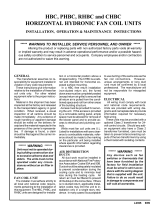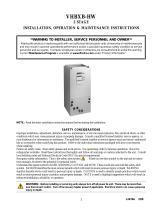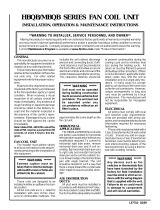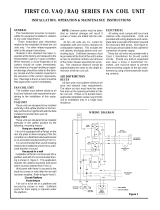
General
*CW-HW(X)
:
Installation, Operation, and Maintenance Instructions
2
Recognize safety information. This is the general safety-alert symbol .
When you see this symbol on the unit and in instruction manuals, be alert to
the potential for personal injury or damage to equipment. The lightning bolt
symbol signifies an electrical shock hazard.
WARNING: This WARNING signifies general hazards which could result in personal
injury or death.
WARNING: This WARNING signifies electrical shock hazards which could result in
personal injury or death.
CAUTION: CAUTION is used to identify unsafe practices which would result in
product and property damage.
NOTE: NOTE is used to highlight suggestions which may result in enhanced
installation, reliability, or operation.
G
ENERAL
The manufacturer does not warrant equipment subjected to abuse. Metal chips,
dust, drywall tape, paint overspray, etc. can void warranties and liability for
equipment failure, personal injury, and property damage.
The manufacturer assumes no responsibility for equipment installed in
violation of any code requirement.
WARNINGS:
• Always wear eye protection when working on equipment.
•
Before servicing unit, always turn off all power to unit. There may be
more than one disconnect switch. Electrical shock can cause personal
injury or death.
•
When fan coil is operating, some components are operating at high
speeds. Personal injury can result from touching these items with any
object.
•
All electrical and service access panels must be secured in their proper
place before operating equipment.
•
Clear surrounding area of all tools, equipment and debris before
operating unit.
CAUTION: Unit must not be operated during building construction due to excessive
airborne dust and debris. Also, the unit must never run under any
circumstances without an air filter in place.
These instructions give information for installation of CW-HW(X) fan coil units
only. For other related equipment, refer to the manufacturer’s instructions.
Material in this shipment has been inspected at the factory and released to the
transportation agency in good condition. When received, a visual inspection of
all cartons should be made immediately. Any evidence of rough handling or
apparent damage should be noted on the delivery receipt and the material
inspected in the presence of the carrier’s representative. If damage is found, a
claim should be filed against the carrier immediately.
All models are designed for indoor installation only. The installation of this
unit, field wiring, duct system, and other related equipment must conform to
the requirements the National Electric Code, ANSI/NFPA No. 70 (latest edition)
in the United States, as well as any state laws and local codes. Local authorities
having jurisdiction should be consulted before installation is made. Such















